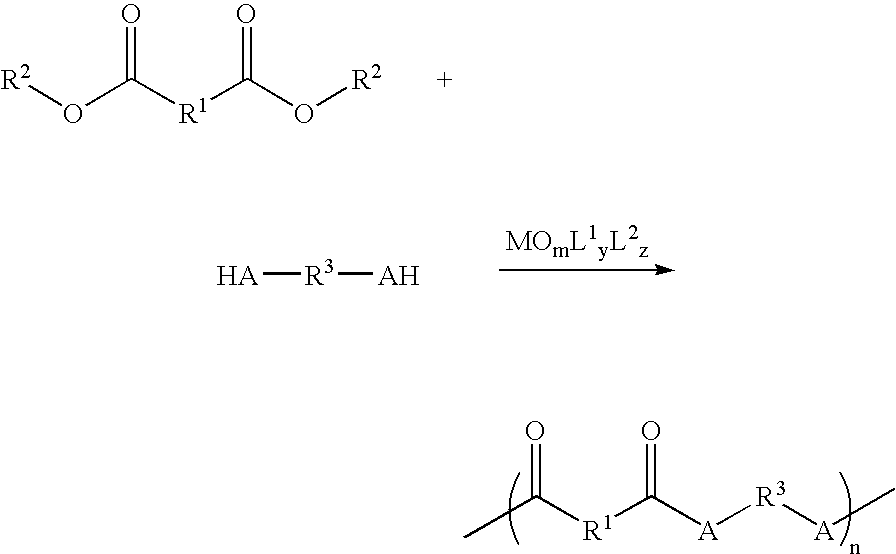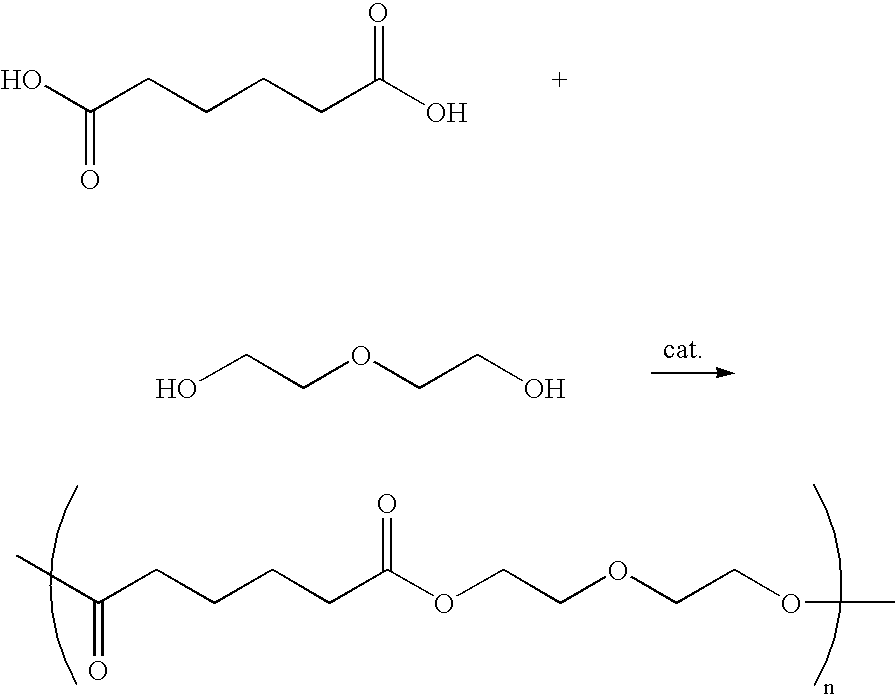Nucleophilic Acyl Substitution-based Polymerization Catalyzed by Oxometallic Complexes
a technology of oxometallic complexes and nucleophilic acyl, which is applied in the field of nucleophilic acyl substitution-based polymerization catalyzed by oxometallic complexes, can solve the problems of catalyst by-products that are not water-soluble and toxic to the environment, and the equipment of process equipment needs anti-corrosion treatment, etc., to achieve excellent catalytic function, high water and air compatibility, and significant reduction
- Summary
- Abstract
- Description
- Claims
- Application Information
AI Technical Summary
Benefits of technology
Problems solved by technology
Method used
Image
Examples
example 1
Process of the Acyl Substitution-Based Polymerization:
[0013] A two-necked, 50-mL flask with a stirring bar and is equipped with a Dean-Stark trap. The flask is then vacuum dried by flame and thereby is slowly cooled to room temperature, and is flushed with nitrogen gas. About 1 mL of water is placed inside the trap. 5 mmol of the first monomer with a plurality of carboxyl groups or a plurality of ester groups and 5 mmol of the second monomer with a plurality of protic nucleophilic groups are precisely measured. Then, 10 mL of nonpolar solvent, such as high boiling (cyclo)alkanes, ethers (anisole, dioxane, or DME), haloalkanes (e.g., chloroform or carbon tetrachloride (CCl4), or arenes (e.g., benzene, toluene, ethylbenzene, or xylene) is added. The reaction content in the flask is stirred to become homogeneous while heated up to the refluxing temperature with removal of water. After having been refluxed for 30 minutes, the reaction mixture is then cooled to room temperature. Cataly...
example 2
[0018] The oxometalic complex provided by the invention is used to catalyze the polymerization between the monomer having ester or carboxylic groups on both ends and diol / glycol to form polyester polymers. The reaction is similar to that in example 1.
Polymer Between Terephthalic Acid and 1,4Benzenediol
[0019]1H NMR (400 MHz, CDCl3) δ 8.28 (s, 4H), 7.26 (s, 4H); 13C NMR (100 MHz, CDCl3) δ 164.00, 149.92, 134.93, 130.34, 121.80
Polyethyleneterephthalate (PET)
[0020]1H NMR (400 MHz, CDCl3) δ 8.07 (s, 4H), 4.68 (s, 4H); 13C NMR (100 MHz, CDCl3) δ 166.0, 133.78, 129.60, 66.97
example 3
[0021] In the field of the engineered plastics, transparent resin with excellent mechanical property has been extensively applied in a variety of optical materials. For example, poly(methyl methacrylate) (PMMA) and polycarbonate (PC) are usually applied in compact discs, laser discs, transparent substrates, optical lenses, dash boards, car windshields and so forth. PMMA has advantages of high transparency and low optical anisotropy but it is apt to absorb water. Therefore, the PMMA product tends to deform and has moderate stability. On the other hand, PC has advantages of high transparency and good heat-resistance but it has moderate fluidity. Therefore, the PC product has obvious birefringence phenomenon. According to the above reasons, neither PMMA nor PC can satisfy the requirements of the optical materials in the current technology.
[0022] Particularly, during the development of flat panel displays, flexible substrate is the main demand in recent years. In addition to the needs ...
PUM
| Property | Measurement | Unit |
|---|---|---|
| carbon number | aaaaa | aaaaa |
| temperature | aaaaa | aaaaa |
| thickness | aaaaa | aaaaa |
Abstract
Description
Claims
Application Information
 Login to View More
Login to View More - R&D
- Intellectual Property
- Life Sciences
- Materials
- Tech Scout
- Unparalleled Data Quality
- Higher Quality Content
- 60% Fewer Hallucinations
Browse by: Latest US Patents, China's latest patents, Technical Efficacy Thesaurus, Application Domain, Technology Topic, Popular Technical Reports.
© 2025 PatSnap. All rights reserved.Legal|Privacy policy|Modern Slavery Act Transparency Statement|Sitemap|About US| Contact US: help@patsnap.com



